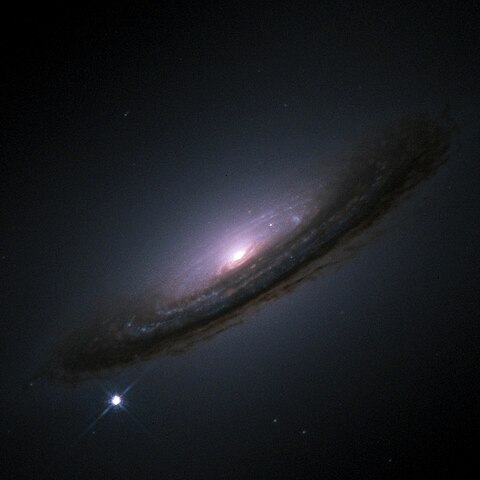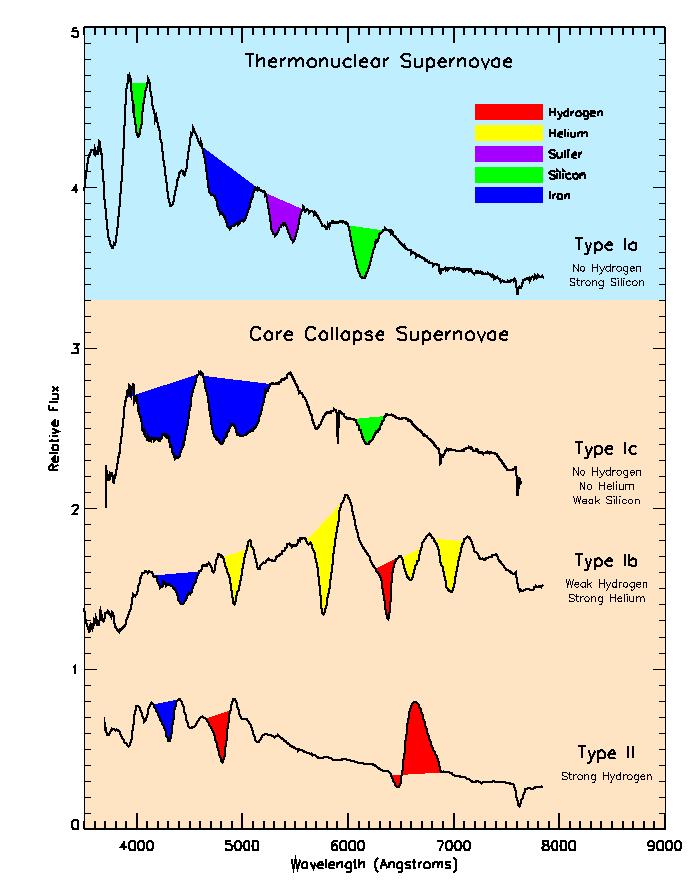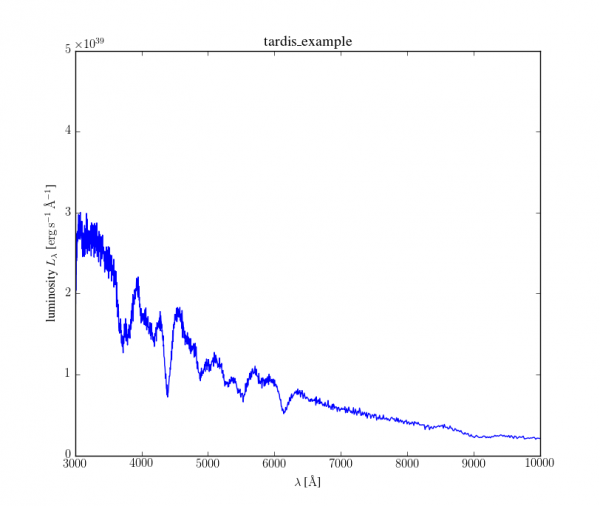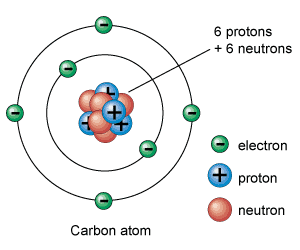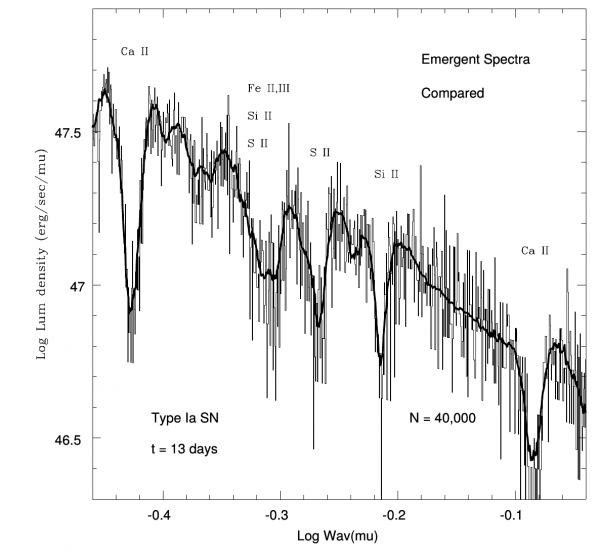This is an old revision of the document!
Table of Contents
TARDIS GSoC 2016 Ideas Page
A bit of astronomy and astrophysics background information
A supernova (here we show SN1994D in the Galaxy NGC4526 - image source: wikipedia) marks the brilliant death throes of a star, during which it outshines its entire galaxy. It not only marks death, though: supernova ejecta change the evolution of the universe and enable the formation of planets and life as we know it. From the iron in your blood to the gold in your jewelry, supernovae return heavy elements assembled from the primordial hydrogen and helium left after the big bang.
There are still many mysteries surrounding supernovae (e.g. their precise origins, inner workings, …). One way to study these objects in more detail is to split the light coming from these objects into its components (like using a prism) and analyzing the resulting data (which is called a spectrum). Here, we show spectra (black lines) of a number of different supernova types (image courtesy Daniel Kasen and LBL). Different chemical elements present in the supernova leave their mark on the spectra by imprinting characteristic features, so-called atomic lines (regions highlighted in colour). Thus, studying and interpreting such spectra allows us to identify what supernovae are made of.
With sophisticated computer simulations astronomers try to reproduce the observed spectra to draw conclusion about the properties of the supernova ejecta and ultimately the explosion mechanism and progenitor stars. TARDIS is such a numerical code. It calculates theoretical spectra based on a number of input parameters, such as the supernova brightness and the abundances of the different chemical elements present in the ejecta (e.g. Oxygen, Silicon, Iron, etc.). The main idea for this procedure is that by finding a close match between theoretical and observed spectra we identify the parameters that actually describe the supernovae.
The TARDIS project
As mentioned in the background information above, TARDIS is a scientific tool (more specifically a Monte Carlo radiative transfer code) whose primary goal is the calculation of theoretical spectra for supernovae. Below, you find the typical result of a TARDIS calculation. It shows the calculated synthetic spectra for a simple supernova model. This particular setup (tardis_example) is officially provided by the TARDIS collaboration on the documentation.
TARDIS aims to be an easy to use piece of software for research and training purposes. Unlike many other scientific codes, we have purposefully made it open-source. This enables scientists to use the code to analyze their observations, but also to review the code and potentially fix errors.
List of GSoC 2016 project ideas
In the TARDIS collaboration we first establish a detailed plan on implementing new features before starting the actual work. This is an important step that ensures that the entire TARDIS collaboration is informed about the development efforts and that the team members can help shape the ideas during the discussion phase. We call these documents TNo PEP - TARDIS Enhancement Proposals. We already have a great list of ideas at https://github.com/tardis-sn/tep that we need help with. Some of these we have specially selected for GSoC 2016 and are listed with specific “warm-up” tasks below. But feel free to propose your own TEP and make a PR on that.
If you use one of our TEPs, you can definitely add more detail to the implementation, but what we really want to see is a detailed timeline with milestones that shows us that you have thought about how to implement the feature in three months. For any questions about the projects, please ask on our mailing list tardis-gsoc-2016@googlegroups.com or on Gitter.
Testing
Difficulty: Easy
Astronomy knowledge needed: None
Mentors: W. Kerzendorf, S. Lietzau
Programming skills: Python
Related TEP: TEP001
Description: Testing a scientific code like TARDIS is very important. We need to ensure that the scientific insights we gain using the code are not based on bugs. Open collaboration with GitHub is great, but the more people work on the code the more opportunities there are to introduce bugs. Making sure that the code doesn't change or only changes as we expect it, is thus an important part of TARDIS development.
We have two kind of tests: 1) Unit tests that test small portions of the code. 2) Full tests that run the code with different settings and make sure that the outcome stays the same. This project concerns itself with the full tests. We only use very few and not computationally expensive full tests as it is impractical for us to run these tests within our normal testing framework.
Thus we want to add a new testing mode to our current test suite - the slow tests. We need your help with that!
Your first objective if you choose to accept the mission: Mark the TARDIS full test as slow and make it easy to enable it's execution only with a commandline option to `py.test`
Writing Models to file
Difficulty: Easy
Astronomy knowledge needed: None
Mentors: W. Kerzendorf, S. Lietzau
Programming skills: Python
Related TEP: TEP002
Description: TARDIS studies how light travels through a supernova and how it ultimately appears to us. We are researching this process and thus are interested in analyzing TARDIS outputs in great deal. This means that we aim at capturing the full state of a TARDIS calculation in more detail. TEP002 describes the ideas in some detail and we want you to help us to implement these.
Your first objective if you choose to accept the mission: Write a `.to_hdf` function for the `MontecarloRunner` class in TARDIS that saves some of the important arrays to an HDF5 file.
Atomic Datasets
Difficulty: Moderate
Astronomy knowledge needed: None/Low - might be helpful
Mentors: L. Shingles, W. Kerzendorf
Programming skills: Python, Parsing, Databases (SQLAlchemy experience would be great)
Related TEP: TEP004
Description: In addition to the input parameters (brightness of the supernova, ejected mass of the different chemical elements, etc.), TARDIS requires data for describing the structure of atoms from different elements (e.g. a sodium atom is differently structured than an iron atom; see the figure for a quick overview for carbon).
This data is not measured by astronomers, but is most often gathered in a lab by atomic physicists. As measurement equipment gets more and more precise, so do the measured structures of different elements. Thus these values update from time to time and are often available in simple ASCII files (http://kurucz.harvard.edu/atoms/1401/gf1401.gam). While we have compiled a small atom data set from some specific sources for our initial work, we would like to get a collection of parsers that can read the different ASCII formats of the group and put this information in a uniform database.
For this project you would help us make parsers for a variety of formats from a collection of atomic data sources (see the TEP) and in the second part put this into a database. The assembled database will not only be very interesting for us, but also for many other fields of astronomy that do rely on atomic data. A useful resource of understanding atomic structure description can be found in http://www.physics.byu.edu/faculty/bergeson/physics571/notes/L27spectnotation.pdf.
Your first objective if you choose to accept the mission: Write a download function to download the atomic weights and symbols and so on from this page http://physics.nist.gov/cgi-bin/Compositions/stand_alone.pl?ele=&all=all&ascii=html. Then build a simple sqlalchemy database with one table and put it in there. “Bonus objective”: Write a parser for (http://kurucz.harvard.edu/atoms/1401/gf1401.gam) using pyparsing.
New module for the creation of spectra
Difficulty: Hard
Astronomy knowledge needed: Medium
Mentors: U. Noebauer, C. Vogl
Programming skills: Python, C, Cython
Related TEP: TEP005
Description: TARDIS's main task is to create spectra that can be compared with observations. In order to use TARDIS to estimate parameters of real supernovae, we need to select TARDIS simulation parameters in such a way so as to produce spectra resembling those of real supernovae. When having a real spectrum, however, we don't know what those simulation parameters may be.
We use a method that uses random numbers to simulate the flow of light through the supernova envelope. But that also generates noise in the final output spectrum. We would like to implement a better solution for this, by using the formal integral solution developed by Lucy 1999, as proposed in TEP005. In the figure below, the benefit of this new spectrum reconstruction method (shown as the thick black line) compared to the standard Monte Carlo counting approach (noisy histogram) is illustrated (image taken from Lucy 1999, fig. 4):
This project requires a bit of physics knowledge.
Your first objective if you choose to accept the mission: Implement a simple counting estimator, storing the number of Monte Carlo packets that come into resonance with each atomic line transition. For this, look into the main Monte Carlo part of TARDIS and find the location where the j_blue_estimators are incremented. This would be the place to insert your counters.
Handling nuclear decay in TARDIS
Difficulty: Medium/Hard
Astronomy knowledge needed: Low/None
Mentors: W. Kerzendorf, U. Noebauer
Programming skills: Python
Related TEP: TEP007
Description: Supernova are powered by the decay of radioactive elements and thus if we want to simulate supernovae we also need to take this physical process into account. Currently, this is done in a very difficult and not easily extensible way in TARDIS. We have thought about adding more support for this and need your help with this.
Your first objective if you choose to accept the mission: Work on PR https://github.com/tardis-sn/tardis/pull/409 and try to get as far as possible it finish it.
A better configuration system
Difficulty: Medium
Astronomy knowledge needed: None
Mentors:
Programming skills: Python
Related TEP: TEP006
Description: TARDIS is a complex piece of software and has many options that can be switched on and off. This means that the Configuration modules have to be able to take a variety of input forms, parse them, validate that the input is in someway sensible (that if a float is expected there is no string given). We have thought about how to make this easier to use and have come up with YAML tags. They are a great way to parse strings to the right format and make sure that the input is valid.
Your first objective if you choose to accept the mission: Parse the string `5 km/s` using YAML tags and convert it to an AstroPy quantity. Bonus objective Look how you would use JSONSchema to replace our validation system and write it in your application.
Tighter integration of Atomic Data, Plasma and Model
Difficulty: Hard
Astronomy knowledge needed: Low
Mentors:
Programming skills: Python
Related TEP: TEP008
Description: TARDIS needs to calculate the Plasma state very often during the runtime. TARDIS should also be able to use different modules with different approximations how to calculate the plasma state. Last year we updated the plasma module to allow a more modular approach. While we got far, this new framework is not yet completely embedded in the code and we will need your help with finalizing the integration.
Your first objective if you choose to accept the mission:
Add a class to the plasma part that dynamically provides the tables of a hdf5 file to the networkx graph.

